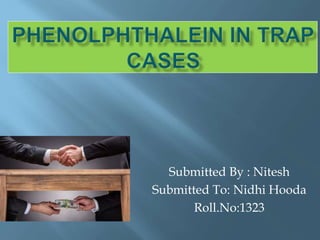Phenolphthalein in trap cases
- 1. Submitted By : Nitesh Submitted To: Nidhi Hooda Roll.No:1323
- 2. ’é© A trap is a method of deliberate laying of the bait and catch the accused person red handed. ’é© ŌĆśBriberyŌĆÖ is a term used for any act of giving gift or money, with dishonest nature for altering its recipientŌĆśs behavior. ’é© Section 171 B of Indian Penal Code, 171E- Punishment for bribery . ’é© Phenolphthalein powder is used as a proof that the person has accepted the bribe.
- 3. ’é© Phenolphthalein is being used in most of the anti- corruption cases. ’é© A white, crystalline compound, C20H14O4, used as an indicator in acid-base titration. ’é© As an indicator of a solutionŌĆÖs pH, phenolphthalein is colorless in acidic and attains a pink to deep red hue in basic solutions. ’é© Phenolphthalein is slightly soluble in water and usually is dissolved in alcohols. ’é© It also serves as a component of universal indicator, together with methyl red, bromothymol blue, and thymol blue.
- 4. ’é© Phenolphthalein can be synthesized by condensation of phthalic anhydride with two equivalents of phenol under acidic conditions. ’é© The reaction can also be catalyzed by a mixture of zinc chloride and thionyl chloride
- 5. ’é© A trap can be laid in 3 scenarios. To catch the bribe taker, to catch the bribe giver, and the cross-trap: to catch both, the bribe giver and the bribe taker. ’é© First step is to complaint whenever to set a trap. ’é© Verification of complaint and complainant takes place. ’é© A sub-inspector may have to go with the complainant as his friend/brother/relative.
- 6. ’é© The accused must himself demand the bribe in exchange for discharging his public duties ’é© Try to negotiate the amount with the accused so that the demand made by the accused gets confirmed and the same is recorded on the camera and the bugging device. ’é© The complainant should not initiate any mention of the money by himself.
- 7. ’é© Sodium carbonate. ’é© Currency notes smeared with phenolphthalein powder ’é© Bottle containing distilled/mineral water (2├Ś500 ml.). ’é© Tea spoon, beakers (2├Ś500 ml.). ’é© Glass bottles with leak-proof lids (minimum 150 ml.). ’é© Paper envelopes for keeping currency notes and marking cloth for sealing exhibits. ’é© Labels for sticking on bottles, carbon paper, paper, candle and match box. ’é© Cotton roll and disposable gloves. ’é© Equipment for video recording and voice recorder. ’é© Trap Laying Officer should carry a mobile phone with him for videography / photography.
- 8. ’é© Currency notes-their denomination and serial number are again noted down. ’é© Hand wash of bribe taker on which phenolphthalein got transferred. ’é© Wash of pocket of shirt/pants/coat/other clothes in which currency notes are kept. ’é© Wash of table/drawer of table, file or paper on which notes are kept. ’é© Videography, voice recorder for recording of conversation between the accused and the complainant on the day of the trap and before the time of trap.
- 9. ’é© pH Test: the pH of the solution is examined with the pH paper. More than pH 9 (range 8.3-10) with pink /red color shows the positive test for the presence ofphenolphthalein. ’é© Acid ŌĆōAlkali Test: On addition of few drops dilute hydrochloric acid(HCl), pink colour disappears. Now add few drops of dilute solution of sodium hydroxide(NaOH) in water, the pink colour reappears. Appearing and disappearing of pink colour indicates the positive test for the presence of phenolphthalein.
- 10. ’é© THIN LAYER CHROMATOGRAPHY ’é© UV-SPECTROSCOPY ’é© HIGH PERFORMANCE LIQUID CHROMATOGRAPHY ’é© HIGH PERFORMANCE THIN LAYER LIQUID CHROMATOGRAPHY
- 11. ’é© Establish the presence or absence of phenolphthalein and sodium carbonate in the pink solution ’é© Presence of phenolphthalein on currency notes ’é© Presence/absence of phenolphthalein residue in the pockets of clothes, briefcase, et












